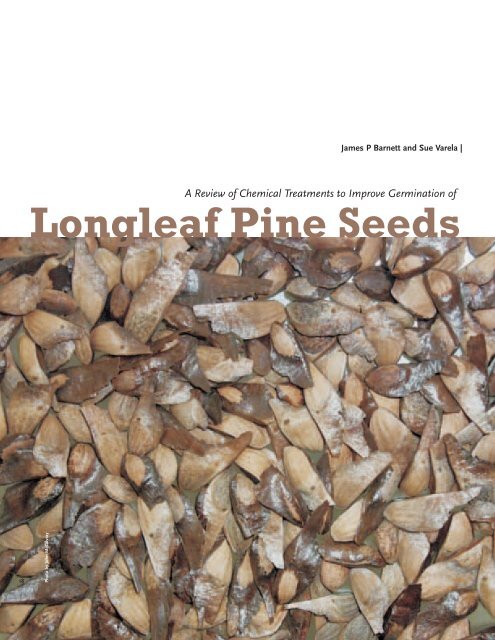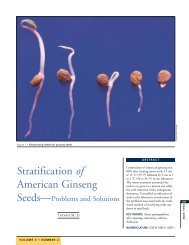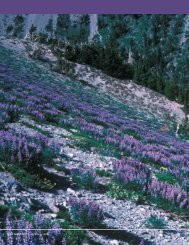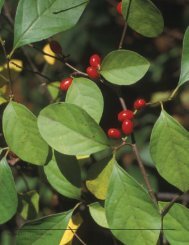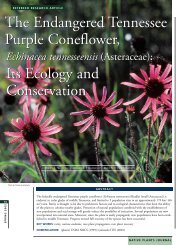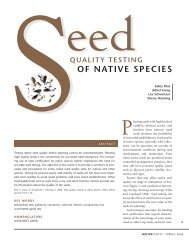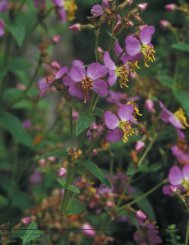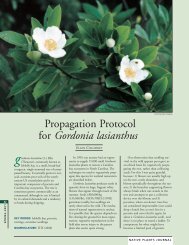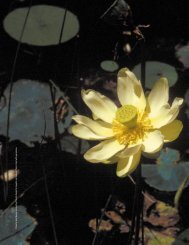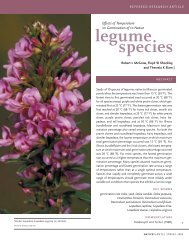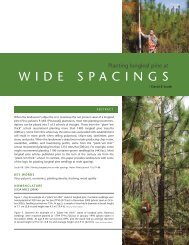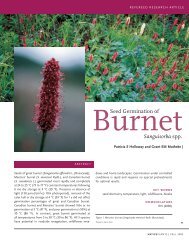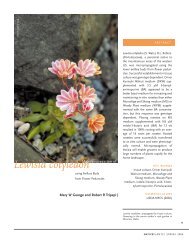Longleaf Pine Seeds - Native Plant Network
Longleaf Pine Seeds - Native Plant Network
Longleaf Pine Seeds - Native Plant Network
You also want an ePaper? Increase the reach of your titles
YUMPU automatically turns print PDFs into web optimized ePapers that Google loves.
James P Barnett and Sue Varela |<br />
A Review of Chemical Treatments to Improve Germination of<br />
<strong>Longleaf</strong> <strong>Pine</strong> <strong>Seeds</strong><br />
18<br />
Photo by John McGilvray
ABSTRACT<br />
Nursery managers can improve germination of longleaf pine (Pinus palustris P. Mill.<br />
[Pinaceae]) seeds and seedling establishment by reducing seedborne pathogenic<br />
fungi with appropriate sterilants and fungicides. We have tested many chemicals,<br />
but hydrogen peroxide, thiophanate methyl, and thiram seem to provide the best<br />
results in reducing the large populations of microorganisms carried on the large,<br />
thin, and fibrous seed coats. Our evaluations of longleaf seeds indicate that<br />
Fusarium spp. are major seedborne pathogens that cause mortality to seeds and<br />
newly germinated seedlings. <strong>Seeds</strong> of other southern pines have denser coats and<br />
are less adversely affected by the presence of seedborne pathogens. The increased<br />
demand for longleaf pine seeds in the last few years makes reducing this contamination<br />
an important consideration by seed dealers and nursery managers.<br />
KEY WORDS<br />
Pinus palustris, seed quality, seed coat pathogens<br />
NOMENCLATURE<br />
USDA NRCS (2002)<br />
Interest in restoring longleaf pine<br />
(Pinus palustris P. Mill. [Pinaceae]) on<br />
many sites in the southern US has<br />
increased dramatically over the last<br />
decade. Although the quantity of seeds<br />
collected and seedlings produced has<br />
increased markedly, the quantity and<br />
quality of longleaf pine seeds remain<br />
insufficient to meet demand across the<br />
range of the species. Most nursery managers<br />
would like to be able to maintain<br />
85% or higher germination and 90% or<br />
higher survival after seedling emergence.<br />
Otherwise, sowing more than 1 seed per<br />
container cavity will be necessary and the<br />
subsequent waste of seeds will jeopardize<br />
efforts to produce high-quality crops consistently<br />
and economically (Figure 1).<br />
19<br />
NATIVEPLANTS | SPRING 2004
<strong>Seeds</strong> of other major southern pines<br />
(Pinaceae), loblolly (P. taeda L.), slash<br />
(P. elliottii Engelm.), and shortleaf (P.<br />
echinata P. Mill.) are relatively easy to<br />
collect, process, and maintain. So why<br />
are seed dealers and nursery managers<br />
unable to produce similar quantities of<br />
quality longleaf pine seeds? The answer<br />
to this question is related to the uniqueness<br />
of the species.<br />
The relation between cone maturity<br />
and storage in longleaf is unique among<br />
southern pine species. Germination of<br />
longleaf seeds will not improve with<br />
storage if the cones are not ripe enough<br />
to be opened operationally (McLemore<br />
1975). To ensure that seeds have high viability,<br />
cone collection must be delayed<br />
until the seeds are fully mature. This<br />
shortens the effective cone collection season.<br />
<strong>Longleaf</strong> pines have a lower ratio of<br />
seed coat weight to total seed weight than<br />
other southern pines (Barnett 1976a;<br />
Carpita and others 1983). (This may<br />
explain why seeds of longleaf pine have<br />
little dormancy compared to the other<br />
species.) <strong>Longleaf</strong> pine seeds also have<br />
permanently attached wings, thin seed<br />
coats, and are unusually moist when<br />
extracted from cones. These traits result in<br />
longleaf seeds being the most difficult of<br />
the southern pines to successfully collect,<br />
process, store, and treat without adversely<br />
affecting quality (Wakeley 1954; Barnett<br />
and Pesacreta 1993). The fibrous, irregular<br />
surface of the seed coats provides a good<br />
foothold for microorganisms. Many of the<br />
fungi residing on seeds are pathogenic and<br />
cause seed and seedling mortality (Pawuk<br />
and Barnett 1974; Pawuk 1978), particularly<br />
in longleaf pine seeds of low vigor.<br />
Reducing infestations on seeds with<br />
chemicals has proved to be an effective<br />
means of improving longleaf pine seed<br />
health and performance (Barnett 1976b;<br />
Barnett and others 1999). We review early<br />
and recent efforts to determine efficacy of<br />
chemical treatments to improve longleaf<br />
seed germination and seedling establishment<br />
and relate these responses to those<br />
for other southern pines.<br />
EARLY EVALUATIONS<br />
For many years, the presence of fungi on<br />
southern pine seeds was not considered a<br />
problem because observations indicated<br />
the fungi were saprophytic and did not<br />
reduce germination (Belcher and Waldrip<br />
1972). With the advent of container<br />
seedling culture it became apparent that<br />
seedborne fungi could be an important<br />
cause of seedling mortality. Pawuk and<br />
Barnett (1974) associated Fusarium infection<br />
of container longleaf pine seedlings<br />
with retention of infested seed coats. Testing<br />
was needed, then, to determine if<br />
reduction of microorganisms on longleaf<br />
seed coats would improve germination<br />
and reduce seedling mortality.<br />
Sterilants<br />
Hydrogen peroxide has been used successfully<br />
to sterilize seeds of several tree<br />
species (Trappe 1961); it also has been<br />
evaluated as a germination stimulant for<br />
western conifers and southern pine seeds<br />
(Ching and Parker 1958; Carter and Jones<br />
Photo by James P Barnett<br />
20 Figure 1. A healthy crop of longleaf pine seedlings growing in a southern nursery. Ideally, nursery managers sow a single seed per container cavity.<br />
NATIVEPLANTS | SPRING 2004<br />
CHEMICAL TREATMENTS TO IMPROVE GERMINATION OF LONGLEAF PINE SEEDS
1962). So, disinfecting southern pine seeds<br />
with 3% and 30% hydrogen peroxide<br />
soaks was tested to determine their effects<br />
on reducing fungal contamination and<br />
improving germination (Table 1). The<br />
results indicated that longleaf pine seeds<br />
were heavily infested with fungi, but that a<br />
1-h soak in 30% hydrogen peroxide effectively<br />
removed fungal contamination and<br />
also improved germination of low-vigor<br />
lots (Barnett 1976b).<br />
Although the 1-h soak in 30% hydrogen<br />
peroxide has been used operationally<br />
to improve performance of longleaf pine<br />
seeds (Barnett and McGilvray 1997), it is a<br />
strong oxidant that can cause skin and eye<br />
injuries. Many organizations hesitate to<br />
use this treatment on a large scale because<br />
of safety concerns and have, therefore,<br />
looked to fungicidal seed treatments as a<br />
means to reduce fungal contamination.<br />
Fungicides<br />
Fungicides applied as seed coatings<br />
are commonly used in agriculture to<br />
reduce infestation of fungi on seeds, but<br />
the effect on pine seed germination was<br />
initially unknown. Several fungicides have<br />
been tested for their effect on the germination<br />
of longleaf, slash, loblolly, and<br />
shortleaf pine seeds (Pawuk 1978). Captan<br />
(Captan 50WP, Micro Flo, Lakeland,<br />
Florida; 50% active ingredient (ai): N-<br />
trichlorome-thylthio-4-cyclohexane-1,2-<br />
dicarboimide) and thiram (Thiram 42S®,<br />
Gustafson, Plano, Texas; 42% ai: tetramethylthiuran<br />
disulfide) had the least detrimental<br />
effect on germination—all other<br />
fungicides reduced germination of one or<br />
more of the 4 southern pine species<br />
(Pawuk 1978). This does not mean that<br />
some of these fungicides may not be effective<br />
in reducing fungal infestations. For<br />
instance, benomyl (Benlate 50WP®,<br />
Dupont, Wilmington, Delaware; 50% ai:<br />
methyl-(butylcarba-moyl)-2-benzimidazolecarbamate)<br />
has been an effective fungicide<br />
for seed and seedling application. A<br />
10-min soak in a 2.5% ai benomyl solution<br />
was equally as effective as a 1-h soak<br />
in 30% hydrogen peroxide in controlling<br />
pathogens and improving germination of<br />
longleaf seeds (Barnett and McGilvray<br />
1997; Littke and others 1997; Barnett and<br />
others 1999). However, benomyl has been<br />
withdrawn from the marketplace and<br />
other alternatives are needed.<br />
RECENT STUDIES<br />
Several compounds have been formulated<br />
as potential replacements for<br />
benomyl. Some are in the same chemical<br />
family and should have similar effectiveness<br />
as fungicides for seed and<br />
seedling application. Unfortunately,<br />
only limited evaluations of these, and<br />
other potential chemicals for use with<br />
longleaf pine, have been completed.<br />
In a study by Barnett and McGilvray<br />
(2002), untreated and hydrogen peroxidetreated<br />
seeds were germinated and grown<br />
for 5 mo in small containers. During the<br />
growing period, seedlings received either<br />
no fungicide or biweekly applications of<br />
benomyl, thiophanate-methyl (Fungo<br />
50WSB Flo®, Scotts-Sierra, Marysville,<br />
Ohio; 46.2% ai: dimethyl 4,4-0-phenyl-<br />
TABLE 1<br />
Germination and fungal infestation of southern pine seeds treated with hydrogen peroxide.<br />
Hydrogen Loblolly Slash Shortleaf <strong>Longleaf</strong><br />
peroxide treatment Germination Infestation Germination Infestation Germination Infestation Germination Infestation<br />
%<br />
None 91 99 81 54 76 15 53 100<br />
3%<br />
4 h 87 19 82 43 82 0 36 13<br />
8 h 93 11 79 44 80 0 26 19<br />
24 h 93 4 50 46 67 0 27 84<br />
48 h 84 2 43 37 73 0 3 82<br />
30%<br />
15 min 88 0 83 0 82 0 49 0<br />
30 min 89 0 85 0 75 0 63 0<br />
1 h 90 0 84 0 48 0 77 0<br />
3 h 44 0 75 0 7 0 54 0<br />
Source: Barnett (1976b).<br />
21<br />
JAMES P BARNETT AND SUE VARELA NATIVEPLANTS | SPRING 2004
22<br />
TABLE 2<br />
<strong>Longleaf</strong> pine seedling percentages from seed and seedling treatments.<br />
Seedling treatment<br />
Seed treatment a<br />
Control Hydrogen peroxide Average<br />
%<br />
Control 78 92 85 a<br />
Benlate ® 85 93 89 b<br />
Fungo-flo ® 88 94 91 b<br />
Fungo-flo ® plus Subdue ® 90 94 92 b<br />
Average 85 a 93 b<br />
a Seedling percentages (numbers plantable in November divided by numbers with an initial germinant)<br />
are averages of 288 seedling cavities for each of 3 replications. Averages within columns and<br />
across rows followed by the same letter are not significantly different at the 0.05 level.<br />
Source: Barnett and McGilvray (2002).<br />
TABLE 3<br />
<strong>Longleaf</strong> pine seed germination and fungal infestation, and seedling development following applications of<br />
several compounds to control seedborne pathogens. a<br />
Seed treatments<br />
Seedling dry weight<br />
Germination Infestation Shoot Root<br />
% g<br />
Control 29 a 99 a 1.98 a 1.35 a<br />
Hydrogen peroxide 43 c 3 c 2.02 a 1.03 c<br />
Cleary 3336F ® 32 b 100 a 2.02 a 1.17 b<br />
Pathguard 6F ® 32 b 84 b 2.61 c 1.29 ab<br />
ZeroTol ® 32 b 100 a 2.29 b 1.24 b<br />
a Means within columns followed by the same letter are not significantly different at the<br />
0.05 level.<br />
This study was a randomized experiment with 3 treatment replications of 150 seeds (6 trays of 50<br />
seeds each) for germination testing, 3 replications of 45 seeds (9 dishes of 5 seeds each) for pathological<br />
evaluations of seed microorganisms, and 3 replications of 3 containers each (45 seedling cavities<br />
per container) for seedling establishment at 90 d.<br />
Source: Barnett (2003).<br />
enebis[3-thioallophanate]), or thiophanate<br />
methyl plus metalaxyl (Subdue 2E®,<br />
Novartis, Greensboro, North Carolina;<br />
N-(2,6-dimethylphenyl)-N-(methoxacetyl)-alamine<br />
methyl) (Table 2). This<br />
study showed that treating seeds with<br />
hydrogen peroxide improved seedling<br />
production without the need for fungicidal<br />
applications to seedlings during<br />
their growth period. The results also<br />
indicated that, in terms of improving<br />
seedling production, treating seedlings<br />
with thiophanate-methyl compounds is<br />
as effective as with benomyl.<br />
In another study, thiophanatemethyl<br />
and chlorothanonil compounds<br />
were evaluated for their effect on seed<br />
germination and pathology and early<br />
seedling development (Barnett 2003).<br />
The treatments were: 1) an untreated<br />
control; 2) a 1-h soak in 30% hydrogen<br />
peroxide; 3) a 10-min soak in a 1.3 ml/l<br />
aqueous solution of thiophanate-methyl<br />
(Cleary 3336F®, Cleary, Dayton, New<br />
Jersey; 41.6% ai: dimethyl 4,4-0-phenylene-bis[3-thioallophanate]);<br />
4) a 10-<br />
min soak in a 2 ml/l aqueous solution of<br />
chlorothanonil (Pathguard 6F®, Whitmire<br />
Micro-Gen, St Louis, Missouri;<br />
54% ai: tetrachloroisophathalonitrile);<br />
and 5) a 10-min soak in a 1:50 dilution<br />
of hydrogen dioxide (ZeroTol®, BioSafe<br />
Systems, Glastonbury, Connecticut;<br />
27% ai).<br />
The 1-h soak in 30% hydrogen peroxide<br />
was the most effective treatment<br />
(Table 3). Chlorothanonil reduced seed<br />
infestations but to a more limited<br />
extent. Chlorothanonil also resulted in<br />
larger seedling top weights 90 d after<br />
germination. Although none of these<br />
chemicals were as effective as hydrogen<br />
peroxide, some may be more effective<br />
for longleaf pine seeds at higher application<br />
rates, or for other conifer species<br />
at recommended rates. Additional studies<br />
are needed to more thoroughly evaluate<br />
the efficacy of these treatments.<br />
Since thiram (applied as a slurry at 5<br />
ml/0.45 kg) has long been a labeled seed<br />
fungicide, it and some newer chemicals<br />
(Vitavax PC® at 2.5 ml/0.45 kg [8 oz/100<br />
lb], Gustafson, Plano, Texas; 45% Captan;<br />
15% PCNB® [pentachloronitrobenzene];<br />
10% Carboxin® [5,6-dihydro-2-methyl-<br />
N-phenyl-1,4-oxathiin-3-carboxamide],<br />
and ABG-3035 [an unregistered fungicide]<br />
at 1 ppm [Gustafson, Plano, Texas])<br />
were evaluated in combination for their<br />
potential in reducing seed coat fungal<br />
contamination and improving germination<br />
of southern pine seeds (Barnett and<br />
Varela 2003). Gustafson Seed Technology<br />
Center (McKinney, Texas) treated seeds<br />
and conducted both pathological and<br />
germination evaluations. Germination of<br />
samples also was conducted at the<br />
<strong>Pine</strong>ville Seed Testing Facility. Results<br />
from the 2 facilities were similar, so only<br />
the Gustafson results are shown (Table 4).<br />
The tests with longleaf pine showed<br />
that Fusarium spp. infested 32% of the<br />
seeds (Table 4). The thiram treatment<br />
reduced the number infested to 12%<br />
and increased germination from 53% to<br />
72%. Although the combination of thiram<br />
and Vitavax further reduced infestation<br />
of the seeds to 2%, it did not<br />
significantly improve germination over<br />
the single thiram treatment.<br />
NATIVEPLANTS | SPRING 2004<br />
CHEMICAL TREATMENTS TO IMPROVE GERMINATION OF LONGLEAF PINE SEEDS
TABLE 4<br />
Levels of seed coat contamination and germination of longleaf pine seeds following treatment with fungicides. a<br />
Seed treatments<br />
Fungus infestation<br />
Penicillium Colletotrichum Fusarium Rhizopus Germination<br />
%<br />
Control 58 2 32 10 53<br />
Thiram 42S ® with colorant 2 0 12 0 72<br />
Thiram 42S ® , ABG-3035 , 4 0 10 0 69<br />
with colorant<br />
Thiram 42S ® , Vitavax PC ® 0 0 2 0 76<br />
Thiram 42S ® , ABG-3035 0 0 8 0 59<br />
Vitavax PC ®<br />
Vitavax PC ® 0 0 16 0 70<br />
a Testing was conducted at the Gustafson Seed Technology Center. Two replications of 50 seeds each were used for all treatment evaluations.<br />
Source: Barnett and Varela (2003).<br />
DISCUSSION<br />
<strong>Longleaf</strong> pine seeds can carry a high<br />
infestation of microorganisms. Fusarium<br />
species seem to be the primary<br />
fungi that are pathogenic to seed germination<br />
and cause seedling mortality.<br />
Several studies have shown that treating<br />
seeds to reduce fungal contamination<br />
significantly improved seed health and<br />
increased both seed germination and<br />
seedling development.<br />
Removing seed coat pathogens by<br />
use of a 1-h soak in 30% hydrogen peroxide<br />
not only improved seed germination<br />
but also reduced the need for<br />
fungicidal applications during seedling<br />
culture. Fungicides that seem particularly<br />
effective in improving seed performance<br />
include thiophanate methyl (a<br />
replacement for benomyl) and thiram.<br />
Other fungicides may have potential but<br />
initial testing has not demonstrated<br />
their effectiveness. These results show<br />
the significant benefit of using seed<br />
treatments on longleaf pine seeds to<br />
control fungi and improve germination.<br />
Chemicals effective for longleaf pine<br />
should work well with any other southern<br />
pine species.<br />
REFERENCES<br />
Barnett JP. 1976a. Delayed germination of southern<br />
pine seeds related to seed coat constraint.<br />
Canadian Journal Forest Research 6:504–510.<br />
Barnett JP. 1976b. Sterilizing southern pine seeds<br />
with hydrogen peroxide. Tree <strong>Plant</strong>ers’ Notes<br />
27(3):17–19, 24.<br />
Barnett JP. 2003. Evaluating thiophanate-methyl<br />
and chlorothanonil compounds for controlling<br />
seed-borne pathogens. <strong>Pine</strong>ville (LA): USDA<br />
Forest Service, Southern Research Station.<br />
FY–2002 FS–PAIP final report. 6 p.<br />
Barnett JP, McGilvray JM. 1997. Practical guidelines<br />
for producing longleaf pine seedlings in<br />
containers. Asheville (NC): USDA Forest Service,<br />
Southern Research Station. General<br />
Technical Report SRS-14. 28 p.<br />
Barnett JP, McGilvray JM. 2002. Guidelines for<br />
producing quality longleaf pine seeds.<br />
Asheville (NC): USDA Forest Service, Southern<br />
Research Station. General Technical<br />
Report SRS-52. 21 p.<br />
Barnett JP, Pesacreta TC. 1993. Handling longleaf<br />
pine seeds for optimal nursery performance.<br />
Southern Journal of Applied Forestry<br />
17:174–179.<br />
Barnett J, Varela S. 2003. Producing high-quality<br />
slash pine seeds. In: Riley LE, Dumroese RK,<br />
Landis TL, technical coordinators. Proceedings<br />
of the national forest and conservation nursery<br />
associations—2002.Ogden (UT): USDA Forest<br />
Service, Rocky Mountain Re-search Station. Proceedings<br />
RMRS-P-28. p 52–56.<br />
Barnett JP, Pickens B, Karrfalt R. 1999. Improving<br />
longleaf pine seedling establishment in the<br />
nursery by reducing seedcoat microorganisms.<br />
In: Haywood JD, editor. Proceedings<br />
tenth biennial southern silvicultural research<br />
conference. Asheville (NC): USDA Forest Service,<br />
Southern Research Station. General<br />
Technical Report SRS-30. p 339–343.<br />
Belcher EW Jr, Waldrip BT Jr. 1972. Effect of thiram<br />
on seed mold and germination of slash<br />
pine seed. Proceedings of Society of Official<br />
Seed Analysts 62:91–93.<br />
Carpita NC, Skaria A, Barnett JP, Dunlap JR.<br />
1983. Cold stratification on growth of radicles<br />
of loblolly pine (Pinus taeda) embryos.<br />
Physiologia <strong>Plant</strong>arum 59:601–606.<br />
Carter MC, Jones L. 1962. The effect of hydrogen<br />
peroxide on the germination of loblolly<br />
and slash pine seed. Asheville (NC): USDA<br />
Forest Service, Southeastern Forest Experiment<br />
Station. Research Paper 141. 12 p.<br />
Ching TM, Parker MC. 1958. Hydrogen peroxide<br />
for rapid viability tests of some coniferous<br />
tree species. Forest Science 4:128–134.<br />
Littke W, Browning J, Morehead C, Miller H,<br />
Milican D, Rose S. 1997. The efficacy of Benlate<br />
seed-dip treatment to control of seedborne<br />
Fusarium disease in containerized<br />
longleaf pine (Pinus palustris). Centralia<br />
(WA): Weyerhaeuser Company, Research<br />
and Development. Technical Report 050-<br />
1422-97-1. 22 p.<br />
23<br />
JAMES P BARNETT AND SUE VARELA NATIVEPLANTS | SPRING 2004
McLemore, BF. 1975. Collection date, cone-storage<br />
period affect southern pine seed yields,<br />
viability. Tree <strong>Plant</strong>ers’ Notes 24(1):24–26.<br />
Pawuk WH. 1978. Damping-off of containergrown<br />
longleaf pine seedling by seedborne<br />
Fusaria. <strong>Plant</strong> Disease Reporter 62:82–84.<br />
Pawuk WH, Barnett JP. 1974. Root rot and<br />
damping-off of container grown southern<br />
pine seedlings. In: Tinus RW, McDonald SE,<br />
editors. Proceedings North American containerized<br />
forest tree seedling symposium.<br />
Denver (CO): Great Plains Agricultural<br />
Council Publication 68. p 173–176.<br />
Trappe JM. 1961. Strong hydrogen peroxide for<br />
sterilizing coats of tree seed and stimulating<br />
germination. Journal of Forestry 59:828–829.<br />
USDA NRCS 2002. The PLANTS database, version<br />
3.5. URL: http://plants.usda.gov (accessed<br />
22 Oct 2002). Baton Rouge (LA): The National<br />
<strong>Plant</strong> Data Center.<br />
Wakeley PC. 1954. <strong>Plant</strong>ing the southern pines.<br />
Washington (DC): USDA Forest Service.<br />
Agricultural Handbook 18. 233 p.<br />
AUTHOR INFORMATION<br />
James P Barnett<br />
USDA Forest Service<br />
Southern Research Station<br />
2500 Shreveport Highway<br />
<strong>Pine</strong>ville, LA 71360<br />
jpbarnett@fs.fed.us<br />
Sue Varela<br />
Gustafson Seed Technology Center<br />
15012 Eldorado Parkway<br />
McKinney, TX 7507<br />
svarela@gustafson.com<br />
24<br />
NATIVEPLANTS | SPRING 2004<br />
CHEMICAL TREATMENTS TO IMPROVE GERMINATION OF LONGLEAF PINE SEEDS


